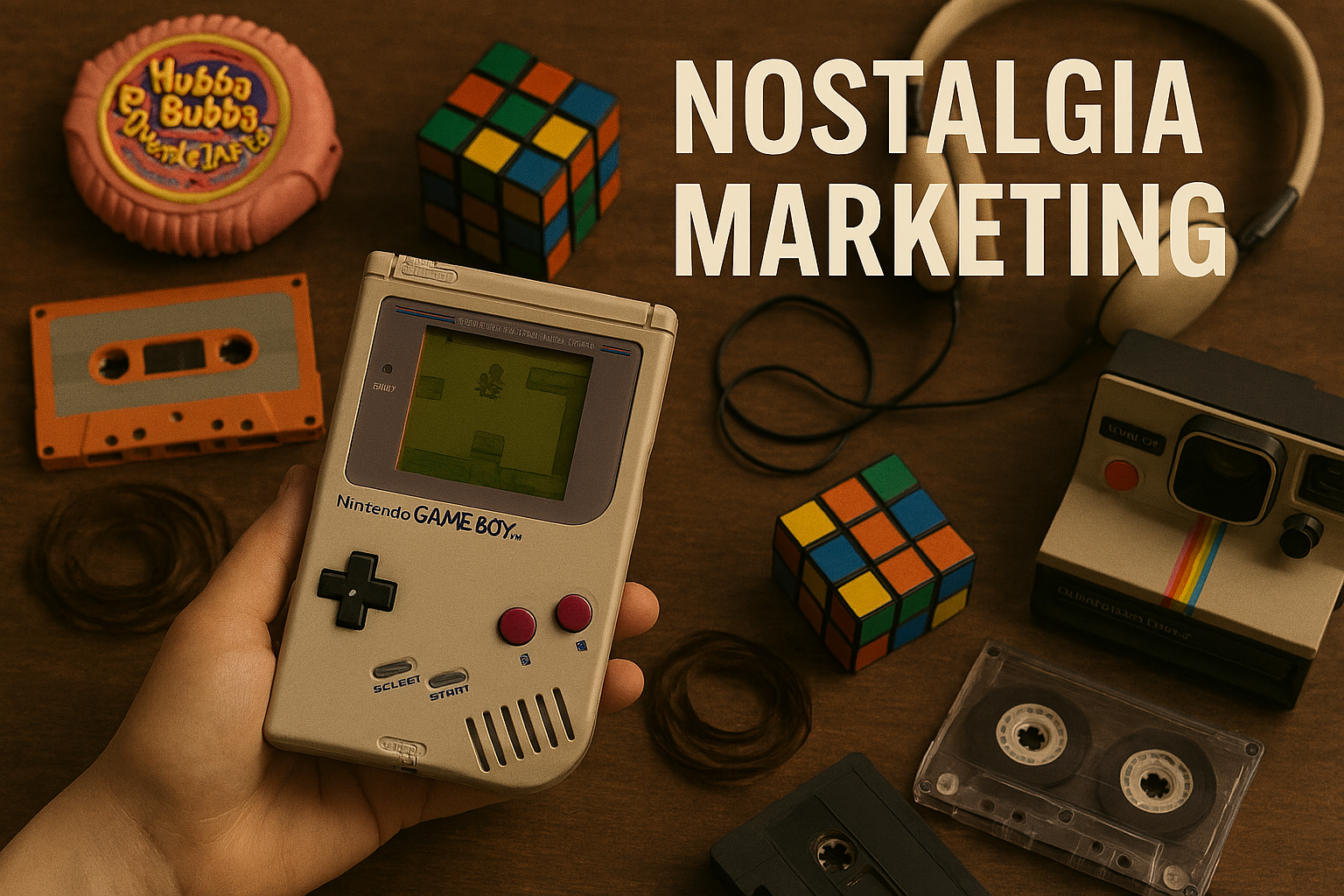
You’re my pumpkin pumpkin, hello honey bunny… remember this childhood jingle?”
It’s funny how just a few words or a tune can transport us back in time, to lazy Saturday mornings, favourite snacks, and simpler days. That’s nostalgia at work, and smart brands know how to harness it. Nostalgia marketing has become a go-to strategy for connecting with audiences on a deeply emotional level. From throwback packaging and reruns of iconic taglines to reboots of vintage campaigns, brands are finding that looking back can be one of the most powerful ways to move forward. In this blog, we’ll explore why nostalgia marketing works so well and how a digital marketing agency can use it to build stronger, more meaningful connections with consumers.
Table Of Contents
- What Is Nostalgia Marketing?
- Why Nostalgia Works So Well
- Real Examples Of Nostalgia Marketing in Action
- The Psychology Behind the Magic
- Should every brand use it?
- Final Thoughts
- FAQs
What Is Nostalgia Marketing?
Nostalgia marketing is when brands tap into people’s fond memories of the past, think childhood cartoons, 90s fashion, old jingles, classic packaging or even outdated tech, to build a deeper emotional connection. It’s not just about using retro aesthetics for fun; it’s about triggering emotions that feel safe, joyful and familiar.
The core idea is simple: if something made you happy once, seeing it again will likely spark that same feeling. And when brands manage to evoke those emotions, consumers are more likely to trust them, engage with them and even buy from them.
This approach works especially well during uncertain times (like economic downturns or post-pandemic phases), when people naturally look back on the “good old days” for comfort. Nostalgia becomes a soft escape, a reminder of simpler, more secure times.
Brands often blend nostalgia with modernity. For instance, they may revive an old product but give it a new-age twist or collaborate with beloved celebrities from the past in a fresh campaign. It’s a clever mix of the past and present, built to stand out in today’s noisy digital landscape.
And it’s not just for older generations. Gen Z is also drawn to nostalgia, but for them, it’s more of a “vintage” aesthetic. Y2K fashion, old-school filters, flip phones, these aren’t memories they’ve lived through, but trends they find cool and comforting in a chaotic world.
Why Nostalgia Works So Well
Nostalgia makes people feel good. It’s like a warm cup of chai on a rainy day, comforting, familiar and instantly uplifting. Research backs this up too: reminiscing about the past can boost mood, lower stress levels and even enhance feelings of belonging and connection.
From a marketing perspective, that emotional lift is pure gold.
When someone sees a childhood cartoon character on a product or hears a jingle from their school days in an advert, it does more than stir memories. It builds trust. It creates a sense of familiarity that’s hard to achieve with something brand new. And in today’s digital-first world, where attention spans are short and competition is fierce, feeling something real matters more than ever.
Nostalgia helps cut through the noise. It makes a brand stand out not by shouting the loudest but by whispering something personal.
This is exactly where a smart digital marketing agency shines, by knowing how to tap into shared cultural memories in just the right way. They might revive an old tagline, use retro visuals or bring back a discontinued product that fans still rave about online.
Real Examples of Nostalgia Marketing in Action
Pepsi – Crystal Pepsi & #ShowYour90s

Pepsi brought back its 1990s “Crystal Pepsi” as a limited edition in 2016 and again in 2022 to great excitement. Their #ShowYour90s social campaign encouraged consumers to share their favourite 90s memories, fuelling engagement and making the revived product a hit.
Nintendo – NES Classic Mini
Nintendo’s launch of the NES Classic Mini in 2016, a compact version of its original 1980s console, let fans relive favourite games from their youth. The product sold out rapidly and bolstered the brand’s image with both older and younger audiences.
Cadbury – #goodluckgirls
The recreation of the Cadbury Dairy Milk ad, especially the 2021 “Good Luck Girls” campaign, involved reimagining their iconic 1993 cricket ad with a bold twist on gender roles. Originally, the 1993 ad featured a male cricketer hitting a century, followed by a young woman running onto the cricket field, joyfully dancing to celebrate his success. In the 2021 version, the roles are reversed: a female cricketer hits a century, and a man runs onto the field dancing in celebration, ushering in a message of empowerment and support for women’s achievements in sports.
The recreated ad used the same music and choreography from the original to evoke nostalgia.
Paper Boat
Paper Boat’s entire brand identity is built on nostalgia. Their drinks feature classic Indian flavours (like Aam Panna, Jaljeera, Jamun) and evoke memories of home and childhood, reinforced by packaging and ad campaigns recalling simpler times, such as making paper boats during rainy days.
Hasbro – Furby Relaunch
View this post on Instagram
In 2023, Hasbro brought back the beloved Furby toy for its 25th anniversary, targeting young parents who remembered owning one as kids while also appealing to their children. It successfully merged updated features with classic design.
Amul
Amul often brings back older, beloved jingles and classic ad characters. The campaign “Amul Doodh Pita Hai India” and its nostalgic billboard ads are iconic, reminding multiple generations of their childhood breakfasts.
HelloFresh – “Friends” Trifle Kit
![campaign poster]](https://florafountain.com/wp-content/uploads/2025/08/hellofresh_friends_110724.png)
HelloFresh partnered with the iconic TV show Friends to sell a limited-edition kit based on Rachel’s famous trifle recipe. Timed for Thanksgiving and Friends’ 30th anniversary, the product quickly sold out and generated buzz among fans.
The Psychology Behind the Magic
When people feel nostalgic, their brains release dopamine, the “feel-good” chemical. This creates a positive emotional association not only with the memory but also with the brand that triggers it.
It’s why ads that feature old-school music, vintage filters or cultural references often get more engagement. People aren’t just seeing a product; they’re reliving a moment. That’s a powerful place for any brand to be.
Moreover, nostalgia creates a sense of trust. If a brand reminds someone of the ‘good old days’, they’re more likely to see it as reliable and familiar. For a branding agency crafting a long-term identity, this can be an excellent strategy to build loyalty.
Should Every Brand Use It?
Not necessarily. Nostalgia only works if it’s authentic and relevant to your audience. If your audience didn’t grow up with a certain reference, it might not land the way you hope.
That’s where strategy matters. It’s important to analyse your target demographics and identify the right nostalgic triggers, be it ‘80s pop culture, ‘90s cartoons or early smartphone-era simplicity.
Also, overusing nostalgia can make a brand feel stuck in the past. The key is to blend familiar elements with fresh thinking so you honour the past while staying current.
Final Thoughts
Nostalgia marketing isn’t just a trend; it’s a timeless strategy when done right. By connecting emotionally, it allows brands to stand out in a crowded digital space and build meaningful relationships with their audience.
Whether you’re a brand looking to reignite loyalty or a branding agency crafting your next campaign, tapping into shared memories might just be the emotional shortcut you need.
After all, sometimes the best way to move forward… is by looking back.
FAQs
It taps into positive emotions and personal memories, making consumers more likely to trust, relate to and remember a brand.
Brands targeting millennials or Gen Z often see strong results, especially in fashion, food, entertainment and tech. However, with the right approach, any brand can benefit.



